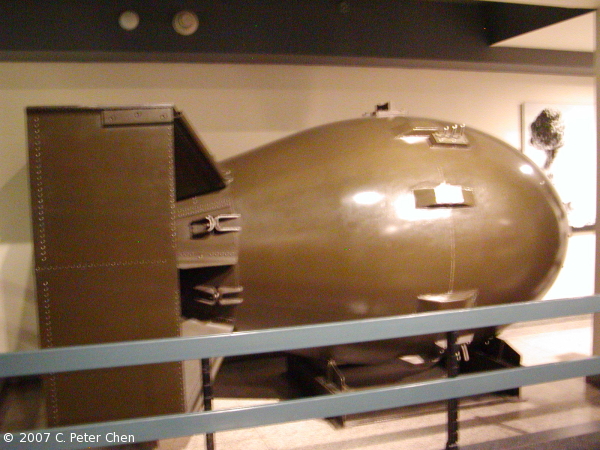
| Caption | Model of the atomic bomb 'Fat Man' on display at the West Point Museum, United States Military Academy, West Point, New York, United States, 22 Sep 2007 ww2dbase | ||||||||
| Photographer | C. Peter Chen | ||||||||
| Source | ww2dbaseC. Peter Chen | ||||||||
| More on... |
| ||||||||
| Photo Size | 600 x 450 pixels | ||||||||
| Photos on Same Day | 22 Sep 2007 | ||||||||
| Added By | C. Peter Chen | ||||||||
| Licensing | used with photographer's permission Please contact us regarding any inaccuracies with the above information. Thank you. |
Did you enjoy this photograph or find this photograph helpful? If so, please consider supporting us on Patreon. Even $1 per month will go a long way! Thank you. Share this photograph with your friends: Stay updated with WW2DB: |
Visitor Submitted Comments
All visitor submitted comments are opinions of those making the submissions and do not reflect views of WW2DB.
Search WW2DB
News
- » Wreck of USS Edsall Found (14 Nov 2024)
- » Autumn 2024 Fundraiser (7 Nov 2024)
- » Nobel Peace Prize for the Atomic Bomb Survivors Organization (11 Oct 2024)
- » Wreck of USS Stewart/DD-224 Found (2 Oct 2024)
- » See all news
Random Photograph
Current Site Statistics
- » 1,150 biographies
- » 337 events
- » 43,917 timeline entries
- » 1,241 ships
- » 350 aircraft models
- » 207 vehicle models
- » 373 weapon models
- » 123 historical documents
- » 260 facilities
- » 470 book reviews
- » 28,536 photos
- » 432 maps
Famous WW2 Quote
"No bastard ever won a war by dying for his country. You win the war by making the other poor dumb bastard die for his country!"George Patton, 31 May 1944
Support Us
Please consider supporting us on Patreon. Even $1 a month will go a long way. Thank you!
Or, please support us by purchasing some WW2DB merchandise at TeeSpring, Thank you!
27 Jan 2017 11:06:54 AM
TEAHOUSE OF THE AUGUST MOON:
THE JAPANESE BOMB
Wartime documents have surfaced, that the Japanese did have a program in the development of a nuclear device. Development started as early as 1937 scientists wanted both the Imperial Army & Navy to fund the project.
NOT A JOINT PROJECT: ONE AGAINST THE OTHER
Working separately the Army & Navy wanted there own bomb. However, with Japan's
early victories in the Pacific, the military didn't believe Japan would need the advantage of a nuclear bomb.
RETHINK THE BOMB:
As the war continued with less victories, the military started to change its mind, and showed its interest again in the project.
Japan lacked any uranium deposits, and relied on taking them by force from the occupied territories. Japan was able to get its hands on 5,000 tons of uranium oxide from Burma and had it shipped to Japan in 1943.
ARMY VS. NAVY:
The Imperial Navy set up its own nuclear program creating the "Nishina Project"
in 1943. The Navy F-GO project was different from the Army's NI-GO project with their use of uranium enrichment.
CLASSIFIED MATERIAL:
At the end of the war, both projects were classified by the US Government and held for decades after the end of World War II, tons of data and documents and related material were kept under great censorship. Did you know that the Japanese bought their Cyclotron in 1938 from UCLA University of California along with others bought later on.
These machines (Cyclotrons) were particle accelerators used in bombarding atoms, with such equipment aspects of nuclear reactions could be tested in the laboratory thus laying the theoretical ground work for atomic weapons...
DELIVERY SYSTEM:
The Germans shipped (12) twelve V-2 rocket to Japan before the collapse of the Third Reich. What became of the rockets is for conjecture and speculation.
The Japanese military lacked operational experience with such weapons and the time needed to bring such weapons on line would take months. However, the Japanese had experience in air-to ground missiles and other technology.
WARTIME DOCUMENTS: WHAT IF...
At wars end the US Armed Forces captured vast amounts of documents dealing with nuclear technology...from both Germany, Italy and Japan. We all know about the German and Italian effort in getting the bomb. But let's also assume that the Japanese were close, or did have such a weapon in the design stages, just maybe the two atomic bombs dropped on Hiroshima and Nagasaki put an end to the Japanese bomb, but I'm only guessing here.
Did you know that thousands of tons of wartime documents will be held in Government archives until 2045. What other secrets are still being held and what other mysteries that will come to light hundreds of years into the future...that have happened since the end of World War II...
DELIVERY SYSTEM: BOMBERS
The Japanese also lacked an operational four-engine bomber, to fly from Honshu, Japan to Los Angeles, California with enough range to strike at other American targets.
ON THE DRAWING BOARD:
Proposed Kawasaki Ki-91 four-engine bomber was set back, the factory planned to build the bomber was bombed by USAAF B-29's in February 1945.
Nakajima Ki-Gi0N1 a six- engine paper design bomber that was never built.
TEAHOUSE OF THE AUGUST MOON: Title came from a 1956 movie.
I thank the editor/ww2db for his continued support. My opinions, conclusions, freedom of expression, do not reflect ww2db in any way.